Brachiaria ramosa (L.) Stapf
Scientific Name: Brachiaria ramosa (L.) Stapf

| General Information | |
|---|---|
| Usda Symbol | BRRA80 |
| Group | Monocot |
| Life Cycle | AnnualPerennial, |
| Growth Habits | Graminoid |
| Native Locations | BRRA80 |
Plant Guide
Alternate Names
Common Names: Dixie signalgrass Scientific Names: Brachiaria ramosa (L.) Stapf; Panicum ramosum L.
Description
General: Browntop millet (Urochloa ramosa) is an introduced, annual/perennial warm-season grass often used in forage/pasture management systems. The stem (culm) may be erect or prostrate along the ground. When growing erect, it may reach 3 ft at maturity. Nodes will appear minutely hairy. The lance-shaped, hairless leaf-blades are ¾–10 inches long (2–25 cm) and 1/8–½ inch (4–14 mm) wide (Clayton et al., 2006). The inflorescence is indeterminate, open, spreading, with a simple axis and stalked flowers. It has 3–15 inflorescences, ⅓–3 inches (1–8 cm) in length, from a central axis. It has white flowers and ellipsoid seeds that are tan in color. It has fibrous roots that can grow to 2 ft deep. Distribution: Browntop millet is an introduced grass that originated in Southeast Asia. It is grown in Africa, western Asia, Arabia, China, and Australia (Clayton, 2006). It was introduced to the United States from India in 1915 (Oelke et al., 1990). In the US, it is mainly grown in the Southeast for hay, pasture, and game bird feed. For current distribution, please consult the Plant Profile page for this species on the PLANTS Web site. Habitat: Browntop millet is a facultative upland (FACU) plant that normally occurs in non-wetlands in the Atlantic and Gulf Coastal Plain, the Eastern Piedmont, and Great Plains. It grows best in sandy loam soils with a pH 5–6.5 (UF, 2007) under full sun.
Adaptation
Browntop millet grows in rocky, shallow soils from sea level up to 8,000 ft (FAO, 2007). It is adaptable to almost all upland soil (Mitchell et al., 1989), but does not grow well in water-restricted, droughty conditions. It will not survive in temperature less than 52°F. Generally, browntop millet and pearl millet (Pennisetum glaucum) are grown in the South/Southeast United States while proso millet (Panicum miliaceum), foxtail millet (Setaria italica), and to a lesser extent Japanese millet (Echinochloa frumentaceae) are mainly grown in the Midwest and Central Plains (Oelke et al., 1990).
Uses
Forage/Feed: Compared to other warm season forage grasses, browntop millet is relatively low yielding. Its strength is that it is a rapidly maturing grass, often used as a catch crop, cover crop, or nurse crop (Miller and Lord, 2007). Browntop millet can yield 1,800–4,000 lb/ac dry matter (FAO, 2007; UF, 2007). These yields are 60–70% of pearl millet or sorghum x Sudangrass hybrids (Hancock, 2010). Browntop millet can accumulate toxic/lethal levels of nitrate and should not be fed to livestock if the plant has been stressed by droughty or cold conditions. Plantings in Minnesota have produced low yields and did not successfully compete with weeds (Oelke et al., 1990). Cover crop/green manure: Browntop millet is used to suppress root-knot nematode populations in tomato and pepper crops in the Southeast (McSorley et al., 1999). It is grown as a fast-growing catch crop between commodity crops, and is not known to be allelopathic. Wildlife: Browntop millet can represent 10–25% of the diet of terrestrial and water birds (USDA NRCS, 2014). It is a prolific seed producer that is planted to attract wild game like pheasants, turkeys, and ducks. In a two-year study by Futch, Duguay, and Tolson (2013), 50% of ingested seed found in mourning doves’ crops was browntop millet. It is also used in deer food plots and as exotic bird feed. Critical Area Planting: Browntop millet is used as a fast-growing cover for erosion control. It is used as a nurse crop in the Southeast until a perennial grass cover is Natural Resources Conservation Service Plant Guide established. Due to its ability to attract granivorous birds (e.g. doves), it should not be used for construction projects near airfields (Washburn and Seamans, 2013). Browntop millet also has the ability to accumulate significant amounts of lead and zinc in shoot and root tissues making it an important plant for remediation of contaminated soils (Lakshmi et al., 2013).
Ethnobotany
There is evidence of the cultivation of browntop millet as a subsistence crop in Neolithic India (Boivin et al., 2014) and it continues to be used as a grain and forage crop in India today (Madella et al., 2013). Grain from taller non-shattering varieties is used as a boiled whole grain, porridge, or unleavened bread (Nesbitt, 2005).
Status
Weedy or Invasive: Browntop millet can become weedy, and may interfere with crop harvest. It produces large amounts of seed and can readily regrow from a viable seed bank, even after several years. It has been found to reduce yield and lower quality of cotton in the southeastern United States (Molin, 2008). Please consult with your local NRCS Field Office, Cooperative Extension Service office, state natural resource, or state agriculture department regarding its status and use. Please consult the PLANTS Web site (http://plants.usda.gov/) and your State Department of Natural Resources for this plant’s current status (e.g., threatened or endangered species, state noxious status, and wetland indicator values).
Planting Guidelines
Browntop millet can be planted in late spring or early summer; May 1–June 15 in Tennessee (Bates et al., 2008) or from mid-April–mid-August in the Southeast (Hancock, 2010). Cold stratification is not required for seed germination. The optimal air temperature for germination is between 63–79°F (FAO, 2007). It grows best in full sun in light-textured, well-drained soils with an optimal pH of 7–7.5. Recommended seeding rates are 14–20 lb/ac drilled and 25–30 lb/ac broadcast (Mitchell and Tomlinson, 1989; MSU, 2010) planted ½ –1 in deep (Woodruff et al., 2010). To avoid overcrowding, seed may be diluted with soybean or corn meal before planting with manually operated seeders (Schonbeck and Morse, 2006). If planted as a nurse crop, lower the seeding rate to 5–10 lb/ac so as not to shade out companion grass or crop (Hancock Seed Co., 2014).
Management
Crop residues from preceding cover crops can suppress browntop millet emergence (Amuri, 2008). Fertilization with phosphorus and nitrogen can help increase forage productivity; rate of application should be determined by the results of soil tests and/or county extension recommendations. To control weeds, it is best to plant in a well-prepared, weed-free bed with narrow row spacing. Chemical weed control options are limited (Baker, 1996). It does not regrow well after cutting so is a one-cut crop.
Pests and Potential Problems
Browntop millet may become infested with armyworms (MSU, 2010), grasshoppers (Baker, 1996), and is susceptible to mung bean yellow mosaic bigeminivirus (Brunt et al., 1996).
Seeds and Plant Production
Plant Production
Plant Production
Browntop millet is a short day (<12 hour) plant that will begin to set seed in 60 days (MSUES, 2010). It can produce 140,000 seeds/lb (Woodruff et al., 2010) and 1,500 lb of seed/ac (Warnell, 2014). Seed should be stored at 13% moisture or less (Oelke, 1990).
Literature Cited
Amuri, N, 2008, Evaluation of the impact of alternative wheat residue and water management on soil properties and soybean yield in a wheat-soybean double-crop system, eastern Arkansas, UMI Microform, Proquest LLC, Ann Arbor, MI, Baker, 1996, Millet production, NMSU Cooperative Extension Guide # A-414, lubbock,tamu,edu/files/2011/10/Millet-Production,pdf (accessed 8/25/2014) Bates, G, C, Harper, and F, Allen, 2008, Forage and field crop seeding guide for Tennessee, UT Extension Document # PB 378, https://utextension,tennessee, Use soil moisture sensors to measure the soil moisture of Brachiaria ramosa (L.) Stapf.,edu/publications/documents (accessed 19 Aug, 2014) Boivin, N,, D,Q, Fuller, R, Korisettar, and M, Petraglia, 2014, The south deccan prehistory project, Karnatak Univ,, School of Oxford, University College London, http://www,homepages,ucl,ac,uk/~tcrndfu/web_project/home,html (accessed 19 Aug, 2014) Brunt, A,A,, K, Crabtree, M,J, Dallwitz, A,J, Gibbs, L, Watson, and E,J, Zurcher, 1996, Plant viruses online: descriptions and lists from the VIDE Database, http://biology,anu,edu,au/Groups/MES/vide (accessed 19 Aug, 2014) Clayton, W,D,, M,S, Vorontsova, K,T, Harman, and H, Williamson, 2006, GrassBase–the online world grass flora, http://www,kew,org/data/grasses-db,html, (accessed 19 Aug, 2014) FAO, 2007, Ecocrop data Sheet: Brachiaria ramosa,
Food
and Agriculture Organization of the UN. http://ecocrop.fao.org/ecocrop/srv/en/dataSheet?id=3814 (accessed 19 Aug. 2014) Futch, W. J. Duguay, and K. M. Tolson. 2013. Seed selection by mourning doves (Zenaida macroura) in northeastern Lousiana. LA Assoc. of Prof. Biolo. and The Wildlife Soc. LA Chap., 2013, Baton Rouge, LA. 15–16 Aug. 2013. Waddill Outdoor Education Center, Baton Rouge, LA. Hancock, D. 2010. Georgia forages: browntop millet. The Univ. of GA College of Ag. and Env. Sci. http://www.caes.uga.edu/commodities/fieldcrops/fora
Conservation
District at http://www.nrcs.usda.gov/ and visit the PLANTS Web site at http://plants.usda.gov/ or the Plant Materials Program Web site: http://plant-materials.nrcs.usda.gov. PLANTS is not responsible for the content or availability of other Web sites.
Plant Traits
Growth Requirements
| Temperature, Minimum (°F) | 52 |
|---|---|
| Adapted to Coarse Textured Soils | No |
| Adapted to Fine Textured Soils | Yes |
| Adapted to Medium Textured Soils | Yes |
| Anaerobic Tolerance | None |
| CaCO3 Tolerance | None |
| Cold Stratification Required | No |
| Drought Tolerance | Low |
| Fertility Requirement | Medium |
| Fire Tolerance | None |
| Frost Free Days, Minimum | 120 |
| Hedge Tolerance | None |
| Moisture Use | Medium |
| pH, Maximum | 6.9 |
| pH, Minimum | 5.5 |
| Precipitation, Maximum | 60 |
| Precipitation, Minimum | 30 |
| Root Depth, Minimum (inches) | 24 |
| Salinity Tolerance | None |
| Shade Tolerance | Intolerant |
Morphology/Physiology
| Bloat | None |
|---|---|
| Toxicity | None |
| Shape and Orientation | Erect |
| Nitrogen Fixation | None |
| Resprout Ability | No |
| Active Growth Period | Spring and Summer |
| C:N Ratio | Medium |
| Coppice Potential | No |
| Fall Conspicuous | Yes |
| Fire Resistant | No |
| Flower Color | White |
| Flower Conspicuous | No |
| Foliage Color | Green |
| Foliage Porosity Summer | Porous |
| Foliage Porosity Winter | Porous |
| Fruit/Seed Color | Brown |
| Fruit/Seed Conspicuous | Yes |
| Growth Form | Bunch |
| Growth Rate | Rapid |
| Height, Mature (feet) | 3.0 |
| Known Allelopath | No |
| Leaf Retention | No |
| Lifespan | Short |
| Low Growing Grass | No |
| Foliage Texture | Fine |
Reproduction
| Propagated by Seed | Yes |
|---|---|
| Propagated by Sod | No |
| Propagated by Sprigs | No |
| Propagated by Tubers | No |
| Fruit/Seed Persistence | Yes |
| Seed per Pound | 75000 |
| Seed Spread Rate | Moderate |
| Seedling Vigor | High |
| Small Grain | No |
| Vegetative Spread Rate | None |
| Propagated by Corm | No |
| Propagated by Container | No |
| Propagated by Bulb | No |
| Propagated by Bare Root | No |
| Fruit/Seed Period End | Winter |
| Fruit/Seed Period Begin | Fall |
| Fruit/Seed Abundance | High |
| Commercial Availability | Contracting Only |
| Bloom Period | Summer |
| Propagated by Cuttings | No |
Suitability/Use
| Veneer Product | No |
|---|---|
| Pulpwood Product | No |
| Protein Potential | Low |
| Post Product | No |
| Palatable Human | No |
| Palatable Graze Animal | Low |
| Palatable Browse Animal | Medium |
| Nursery Stock Product | No |
| Naval Store Product | No |
| Lumber Product | No |
| Fodder Product | Yes |
| Christmas Tree Product | No |
| Berry/Nut/Seed Product | No |

